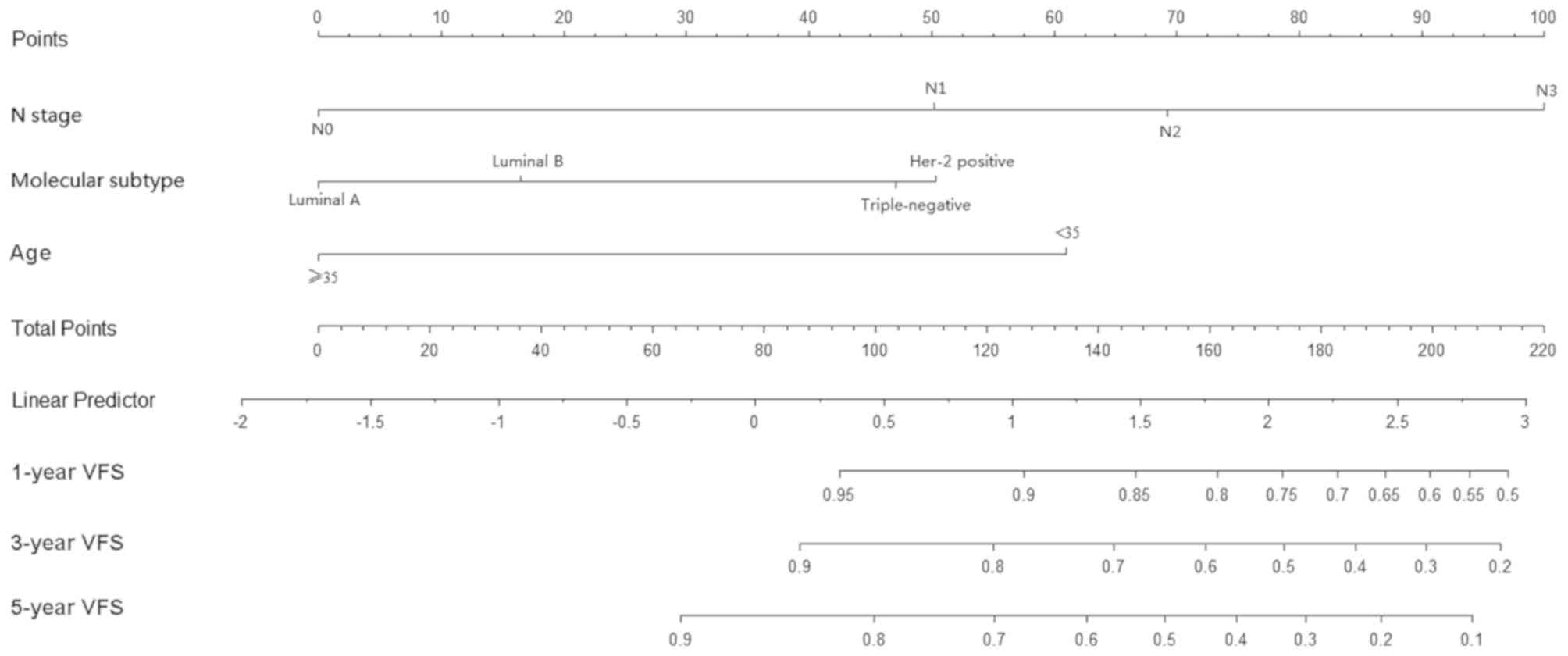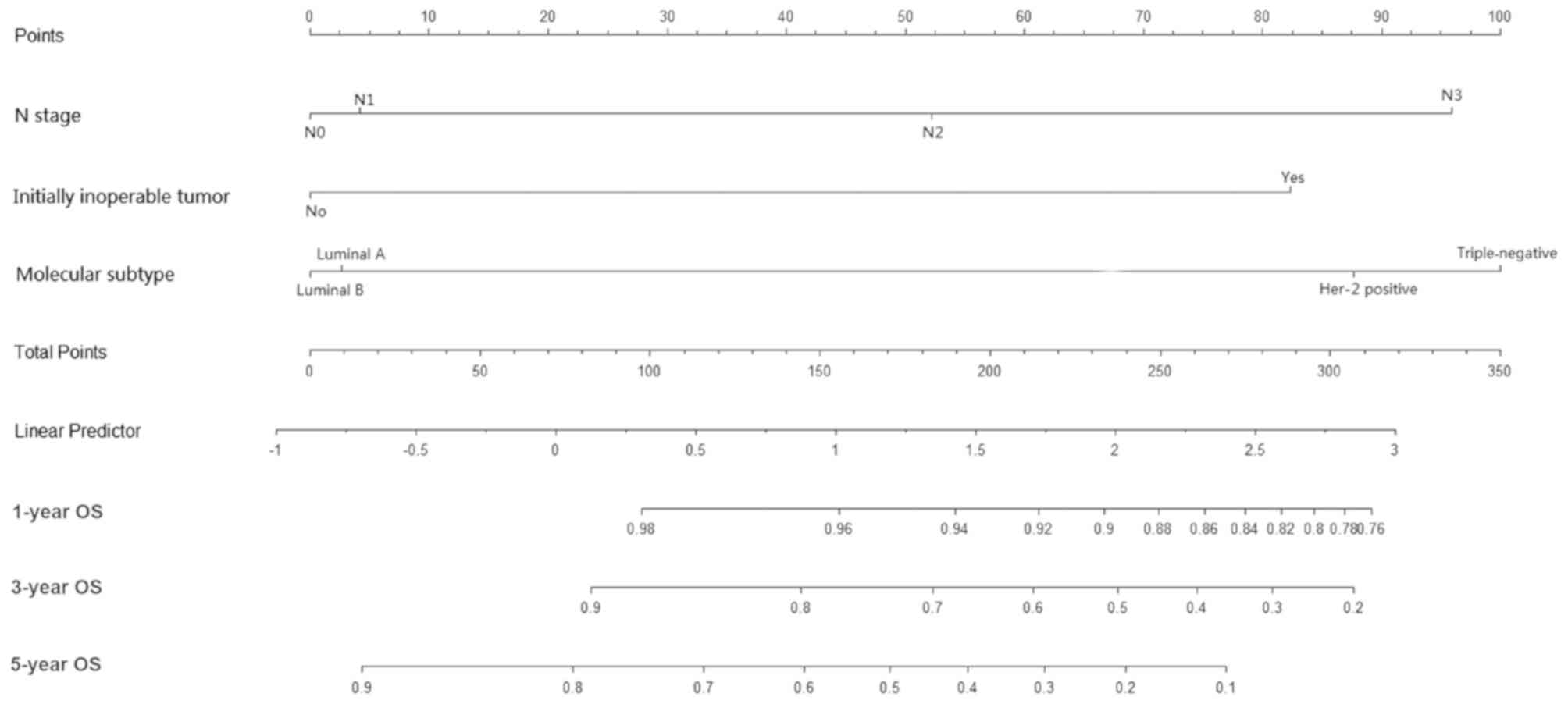|
1
|
DeSantis CE, Bray F, Ferlay J,
Lortet-Tieulent J, Anderson BO and Jemal A: International variation
in female breast cancer incidence and mortality rates. Cancer
Epidemiol Biomarkers Prev. 24:1495–1506. 2015. View Article : Google Scholar : PubMed/NCBI
|
|
2
|
Fan L, Strasser-Weippl K, Li JJ, St Louis
J, Finkelstein DM, Yu KD, Chen WQ, Shao ZM and Goss PE: Breast
cancer in China. Lancet Oncol. 15:E279–E289. 2014. View Article : Google Scholar : PubMed/NCBI
|
|
3
|
Tang LC, Yin WJ, Di GH, Shen ZZ and Shao
ZM: Unfavourable clinicopathologic features and low response rate
to systemic adjuvant therapy: Results with regard to poor survival
in young Chinese breast cancer patients. Breast Cancer Res Treat.
122:95–104. 2010. View Article : Google Scholar : PubMed/NCBI
|
|
4
|
Zabicki K, Colbert JA, Dominguez FJ, Gadd
MA, Hughes KS, Jones JL, Specht MC, Michaelson JS and Smith BL:
Breast cancer diagnosis in women <or=40 versus 50 to 60 years:
Increasing size and stage disparity compared with older women over
time. Ann Surg Oncol. 13:1072–1077. 2006. View Article : Google Scholar : PubMed/NCBI
|
|
5
|
Goksu SS, Tastekin D, Arslan D, Gunduz S,
Tatli AM, Unal D, Salim D, Guler T and Coskun HS: Clinicopathologic
features and molecular subtypes of breast cancer in young women
(age </=35). Asian Pac J Cancer prev. 15:6665–6668. 2014.
View Article : Google Scholar : PubMed/NCBI
|
|
6
|
Tjokrowidjaja A, Lee CK, Houssami N and
Lord S: Metastatic breast cancer in young women: A population-based
cohort study to describe risk and prognosis. Intern Med J.
44:764–770. 2014. View Article : Google Scholar : PubMed/NCBI
|
|
7
|
Keegan TH, DeRouen MC, Press DJ, Kurian AW
and Clarke CA: Occurrence of breast cancer subtypes in adolescent
and young adult women. Breast Cancer Res. 14:R552012. View Article : Google Scholar : PubMed/NCBI
|
|
8
|
Chen HL, Ding A and Wang FW: Prognostic
effect analysis of molecular subtype on young breast cancer
patients. Chin J Cancer Res. 27:428–436. 2015.PubMed/NCBI
|
|
9
|
Liedtke C, Rody A, Gluz O, Baumann K,
Beyer D, Kohls EB, Lausen K, Hanker L, Holtrich U, Becker S and
Karn T: The prognostic impact of age in different molecular
subtypes of breast cancer. Breast Cancer Res Treat. 152:667–673.
2015. View Article : Google Scholar : PubMed/NCBI
|
|
10
|
Azim HA Jr, Nguyen B, Brohee S, Zoppoli G
and Sotiriou C: Genomic aberrations in young and elderly breast
cancer patients. BMC Med. 13:2662015. View Article : Google Scholar : PubMed/NCBI
|
|
11
|
Goldhirsch A, Wood WC, Gelber RD, Coates
AS, Thürlimann B and Senn HJ; 10th St, : Gallen conference:
Progress and promise: Highlights of the international expert
consensus on the primary therapy of early breast cancer 2007. Ann
Oncol. 18:1133–1144. 2007. View Article : Google Scholar : PubMed/NCBI
|
|
12
|
Plichta JK, Rai U, Tang R, Coopey SB,
Buckley JM, Gadd MA, Specht MC, Hughes KS, Taghian AG and Smith BL:
Factors associated with recurrence rates and long-term survival in
women diagnosed with breast cancer ages 40 and younger. Ann Surg
Oncol. 23:3212–3220. 2016. View Article : Google Scholar : PubMed/NCBI
|
|
13
|
Fredholm H, Eaker S, Frisell J, Holmberg
L, Fredriksson I and Lindman H: Breast cancer in young women: Poor
survival despite intensive treatment. PLoS One. 4:e76952009.
View Article : Google Scholar : PubMed/NCBI
|
|
14
|
Hearne BJ, Teare MD, Butt M and Donaldson
L: Comparison of nottingham prognostic index and adjuvant online
prognostic tools in young women with breast cancer: Review of a
single-institution experience. BMJ open. 5:e0055762015. View Article : Google Scholar : PubMed/NCBI
|
|
15
|
Karihtala P, Winqvist R, Bloigu R and
Jukkola-Vuorinen A: Long-term observational follow-up study of
breast cancer diagnosed in women </=40 years old. Breast.
19:456–461. 2010. View Article : Google Scholar : PubMed/NCBI
|
|
16
|
Edge SB and Compton CC: The American joint
committee on cancer: The 7th edition of the AJCC cancer staging
manual and the future of TNM. Ann Surg Oncol. 17:1471–1474. 2010.
View Article : Google Scholar : PubMed/NCBI
|
|
17
|
Alco G, Bozdogan A, Selamoglu D, Pilanci
KN, Tuzlali S, Ordu C, Igdem S, Okkan S, Dincer M, Demir G and
Ozmen V: Clinical and histopathological factors associated with
Ki-67 expression in breast cancer patients. Oncol Lett.
9:1046–1054. 2015. View Article : Google Scholar : PubMed/NCBI
|
|
18
|
Wang S, Saboorian MH, Frenkel E, Hynan L,
Gokaslan ST and Ashfaq R: Laboratory assessment of the status of
Her-2/neu protein and oncogene in breast cancer specimens:
Comparison of immunohistochemistry assay with fluorescence in situ
hybridisation assays. J Clin Pathol. 53:374–381. 2000. View Article : Google Scholar : PubMed/NCBI
|
|
19
|
Shukla S, Pia Patric IR, Thinagararjan S,
Srinivasan S, Mondal B, Hegde AS, Chandramouli BA, Santosh V,
Arivazhagan A and Somasundaram K: A DNA methylation prognostic
signature of glioblastoma: Identification of NPTX2-PTEN-NF-kappaB
nexus. Cancer Res. 73:6563–6573. 2013. View Article : Google Scholar : PubMed/NCBI
|
|
20
|
Tang LC, Jin X, Yang HY, He M, Chang H,
Shao ZM and Di GH: Luminal B subtype: A key factor for the worse
prognosis of young breast cancer patients in China. BMC Cancer.
15:2012015. View Article : Google Scholar : PubMed/NCBI
|
|
21
|
Lee CK, Hudson M, Stockler M, Coates AS,
Ackland S, Gebski V, Lord S, Friedlander M, Boyle F and Simes RJ: A
nomogram to predict survival time in women starting first-line
chemotherapy for advanced breast cancer. Breast cancer Res Treat.
129:467–476. 2011. View Article : Google Scholar : PubMed/NCBI
|
|
22
|
Vernerey D, Huguet F, Vienot A, Goldstein
D, Paget-Bailly S, Van Laethem JL, Glimelius B, Artru P, Moore MJ,
André T, et al: Prognostic nomogram and score to predict overall
survival in locally advanced untreated pancreatic cancer (PROLAP).
Br J Cancer. 115:281–289. 2016. View Article : Google Scholar : PubMed/NCBI
|
|
23
|
Liang W, Zhang L, Jiang G, Wang Q, Liu L,
Liu D, Wang Z, Zhu Z, Deng Q, Xiong X, et al: Development and
validation of a nomogram for predicting survival in patients with
resected non-small-cell lung cancer. J Clin Oncol. 33:861–869.
2015. View Article : Google Scholar : PubMed/NCBI
|
|
24
|
Keam B, Im SA, Park S, Nam BH, Han SW, Oh
DY, Kim JH, Lee SH, Han W, Kim DW, et al: Nomogram predicting
clinical outcomes in breast cancer patients treated with
neoadjuvant chemotherapy. J Cancer Res Clin Oncol. 137:1301–1308.
2011. View Article : Google Scholar : PubMed/NCBI
|
|
25
|
Qiu SQ, Zeng HC, Zhang F, Chen C, Huang
WH, Pleijhuis RG, Wu JD, van Dam GM and Zhang GJ: A nomogram to
predict the probability of axillary lymph node metastasis in early
breast cancer patients with positive axillary ultrasound. Sci Rep.
6:211962016. View Article : Google Scholar : PubMed/NCBI
|
|
26
|
Witteveen A, Vliegen IM, Sonke GS, Klaase
JM, MJ IJ and Siesling S: Personalisation of breast cancer
follow-up: A time-dependent prognostic nomogram for the estimation
of annual risk of locoregional recurrence in early breast cancer
patients. Breast Cancer Res Treat. 152:627–636. 2015. View Article : Google Scholar : PubMed/NCBI
|
|
27
|
Song N, Choi JY, Sung H, Jeon S, Chung S,
Park SK, Han W, Lee JW, Kim MK, Lee JY, et al: Prediction of breast
cancer survival using clinical and genetic markers by tumor
subtypes. PLoS One. 10:e01224132015. View Article : Google Scholar : PubMed/NCBI
|
|
28
|
Hennigs A, Riedel F, Gondos A, Sinn P,
Schirmacher P, Marmé F, Jäger D, Kauczor HU, Stieber A, Lindel K,
et al: Prognosis of breast cancer molecular subtypes in routine
clinical care: A large prospective cohort study. BMC Cancer.
16:7342016. View Article : Google Scholar : PubMed/NCBI
|
|
29
|
Savci-Heijink CD, Halfwerk H, Hooijer GK,
Horlings HM, Wesseling J and van de Vijver MJ: Retrospective
analysis of metastatic behaviour of breast cancer subtypes. Breast
Cancer Res Treat. 150:547–557. 2015. View Article : Google Scholar : PubMed/NCBI
|
|
30
|
Zhao Y, Dong X, Li R, Song J and Zhang D:
Correlation between clinical-pathologic factors and long-term
follow-up in young breast cancer patients. Transl Oncol. 8:265–272.
2015. View Article : Google Scholar : PubMed/NCBI
|
|
31
|
Kast K, Link T, Friedrich K, Petzold A,
Niedostatek A, Schoffer O, Werner C, Klug SJ, Werner A, Gatzweiler
A, et al: Impact of breast cancer subtypes and patterns of
metastasis on outcome. Breast Cancer Res Treat. 150:621–629. 2015.
View Article : Google Scholar : PubMed/NCBI
|
|
32
|
Bartmann C, Diessner J, Blettner M,
Häusler S, Janni W, Kreienberg R, Krockenberger M, Schwentner L,
Stein R, Stüber T, et al: Factors influencing the development of
visceral metastasis of breast cancer: A retrospective multi-center
study. Breast. 31:66–75. 2017. View Article : Google Scholar : PubMed/NCBI
|











